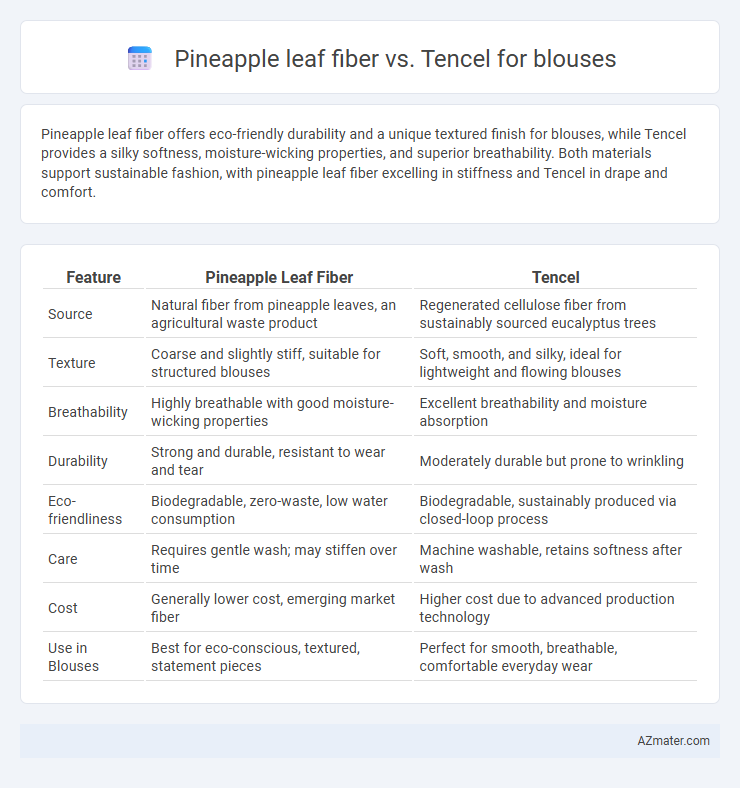Pineapple leaf fiber offers eco-friendly durability and a unique textured finish for blouses, while Tencel provides a silky softness, moisture-wicking properties, and superior breathability. Both materials support sustainable fashion, with pineapple leaf fiber excelling in stiffness and Tencel in drape and comfort.
Table of Comparison
| Feature | Pineapple Leaf Fiber | Tencel |
|---|---|---|
| Source | Natural fiber from pineapple leaves, an agricultural waste product | Regenerated cellulose fiber from sustainably sourced eucalyptus trees |
| Texture | Coarse and slightly stiff, suitable for structured blouses | Soft, smooth, and silky, ideal for lightweight and flowing blouses |
| Breathability | Highly breathable with good moisture-wicking properties | Excellent breathability and moisture absorption |
| Durability | Strong and durable, resistant to wear and tear | Moderately durable but prone to wrinkling |
| Eco-friendliness | Biodegradable, zero-waste, low water consumption | Biodegradable, sustainably produced via closed-loop process |
| Care | Requires gentle wash; may stiffen over time | Machine washable, retains softness after wash |
| Cost | Generally lower cost, emerging market fiber | Higher cost due to advanced production technology |
| Use in Blouses | Best for eco-conscious, textured, statement pieces | Perfect for smooth, breathable, comfortable everyday wear |
Introduction: Comparing Pineapple Leaf Fiber and Tencel for Blouses
Pineapple leaf fiber offers exceptional durability and natural breathability, making it an eco-friendly choice for blouse fabrics. Tencel, a sustainable fiber derived from eucalyptus trees, provides a smooth texture and excellent moisture-wicking properties that enhance comfort. Evaluating these materials for blouses highlights the balance between bio-based innovation and wearability in sustainable fashion.
Origin and Production Process
Pineapple leaf fiber originates from the leaves of the pineapple plant, primarily grown in tropical regions such as the Philippines, where the fibers are manually extracted through a process called decortication, followed by washing and drying. Tencel, a brand name for lyocell, is a semi-synthetic fiber derived from sustainably sourced eucalyptus wood pulp, produced through a closed-loop solvent spinning process that recycles almost all chemicals. The natural origin and eco-friendly mechanical extraction of pineapple fiber contrast with the controlled industrial production and chemical processing methods used for Tencel.
Environmental Impact and Sustainability
Pineapple leaf fiber, derived from agricultural waste, offers a biodegradable and low-impact alternative with minimal water and chemical usage in its production, making it highly sustainable for blouse manufacturing. Tencel, produced from sustainably sourced eucalyptus wood through a closed-loop process, significantly reduces water consumption and chemical discharge, enhancing its environmental credentials. Both fibers contribute to eco-friendly fashion, but pineapple leaf fiber's zero-waste potential and Tencel's renewable sourcing underscore their distinct sustainable advantages.
Texture and Comfort on Skin
Pineapple leaf fiber offers a coarse, slightly stiff texture that provides durability but may feel rougher on the skin compared to Tencel's remarkably smooth, soft, and breathable fabric. Tencel, made from sustainably sourced wood pulp, excels in moisture-wicking and temperature regulation, enhancing comfort for all-day wear. The natural luster and lightweight softness of Tencel make it an ideal choice for blouses designed for sensitive skin and breathable comfort.
Breathability and Moisture-Wicking Properties
Pineapple leaf fiber offers excellent breathability due to its natural porous structure, making it highly effective at allowing air circulation in blouses. Tencel, derived from sustainably sourced wood pulp, boasts superior moisture-wicking properties, efficiently drawing sweat away from the skin to keep the wearer dry. Both fibers provide comfort, but Tencel's advanced moisture management often outperforms pineapple leaf fiber in active or humid conditions.
Durability and Longevity
Pineapple leaf fiber offers exceptional durability due to its natural lignin content, making blouses highly resistant to wear and tear over prolonged use. Tencel, derived from sustainably sourced eucalyptus, combines softness with strong moisture management, ensuring longevity with less fabric degradation and pilling. Blouses made from pineapple leaf fiber generally outperform Tencel in abrasion resistance, while Tencel excels in maintaining shape and comfort after multiple washes.
Ease of Care and Maintenance
Pineapple leaf fiber blouses require gentle hand washing and air drying to maintain their natural texture and durability, as machine washing can cause fiber damage. Tencel blouses offer superior ease of care, being machine washable, quick-drying, and resistant to wrinkles, making them ideal for low-maintenance wardrobes. Both fibers are eco-friendly options, but Tencel stands out for its practicality in everyday garment care and long-term fabric longevity.
Color Retention and Dyeability
Pineapple leaf fiber offers excellent dyeability due to its natural cellulose content, resulting in vibrant and long-lasting colors that resist fading after multiple washes. Tencel, derived from sustainably sourced eucalyptus wood pulp, exhibits superior color retention because of its smooth fiber structure, which allows dyes to bond uniformly and maintain brilliance over time. Both materials support eco-friendly fashion, but Tencel's advanced fiber processing provides more consistent colorfastness compared to the slightly more textured pineapple leaf fiber.
Style Versatility and Design Potential
Pineapple leaf fiber offers a unique, textured aesthetic ideal for eco-conscious, structured blouse designs with natural, earthy appeal. Tencel provides a smooth, silky finish that enhances drape and fluidity, allowing for versatile styles from casual to elegant blouses. Both materials enable creativity; pineapple leaf fiber supports sustainable and tactile fashion, while Tencel promotes comfort and sleek silhouettes in diverse blouse designs.
Price Point and Market Availability
Pineapple leaf fiber blouses are generally more affordable due to the low-cost raw material derived from agricultural waste, making them a sustainable yet budget-friendly option. Tencel blouses, produced from wood pulp through a more complex and eco-friendly process, tend to have a higher price point reflecting their premium sheen and softness. Market availability favors Tencel with widespread distribution in eco-conscious fashion brands, whereas pineapple leaf fiber products remain niche but are growing in demand within sustainable textile markets.

Infographic: Pineapple leaf fiber vs Tencel for Blouse
 azmater.com
azmater.com